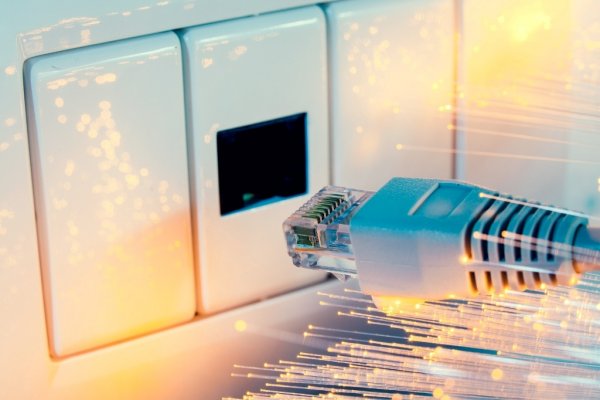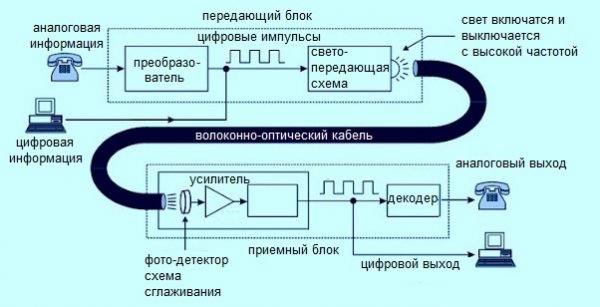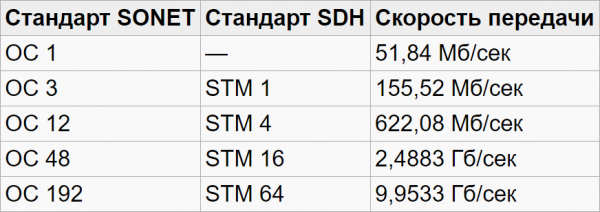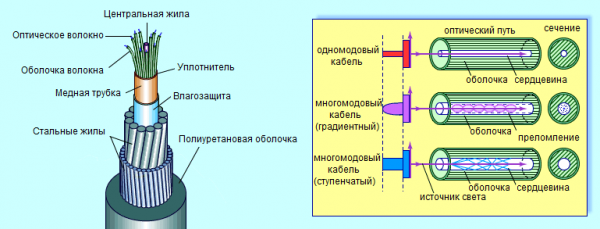The principle of conversion and transmission of information on optical fibers
Modern communication lines intended for the transmission of information over long distances are often just optical lines, due to the rather high efficiency of this technology, which it has successfully demonstrated for many years, for example, as a means of providing broadband access to the Internet.
The fiber itself consists of a glass core surrounded by a sheath with a refractive index lower than that of the core. The light beam responsible for transmitting information along the line propagates along the core of the fiber, reflects on its way from the cladding and thus does not go outside the transmission line.
The beamforming light source is usually diode or semiconductor laser, while the fiber itself, depending on the core diameter and refractive index distribution, can be single-mode or multi-mode.
Optical fibers in communication lines are superior to electronic means of communication, enabling high-speed and lossless transmission of digital data over long distances.
In principle, optical lines can form an independent network or serve to unite already existing networks — sections of optical fiber highways physically united at the level of optical fiber or logically — at the level of data transmission protocols.
The speed of data transmission over optical lines can be measured in hundreds of gigabits per second, for example the 10 Gbit Ethernet standard, which has been used for many years in modern telecommunications structures.
The year of the invention of fiber optics is considered to be 1970, when Peter Schultz, Donald Keck and Robert Maurer—scientists at Corning—invented a low-loss optical fiber that opened up the possibility of duplicating the cable system for transmitting the telephone signal without repeaters are used. The developers have created a wire that allows you to save 1% of the optical signal power at a distance of 1 kilometer from the source.
This was the turning point for technology. Lines were originally designed to transmit hundreds of phases of light simultaneously, later single-phase fiber was developed with higher performance capable of maintaining signal integrity over longer distances. Single-phase zero-offset fiber has been the most sought-after fiber type since 1983 until today.
To transmit data over an optical fiber, the signal must first be converted from electrical to optical, then transmitted down the line, and then converted back to electrical at the receiver.The entire device is called a transceiver and includes not only optical but also electronic components.
So, the first element of an optical line is an optical transmitter. It converts a series of electrical data into an optical stream. The transmitter includes: a parallel-to-serial converter with a sync pulse synthesizer, a driver and an optical signal source.
The source of the optical signal can be a laser diode or an LED. Conventional LEDs are not used in telecommunication systems. The bias current and the modulation current for direct modulation of the laser diode are supplied by the laser driver. Then the light is supplied through the optical connector—into the fiber optic cable.
On the other side of the line, the signal and the timing signal are detected by an optical receiver (mostly a photodiode sensor) where they are converted to an electrical signal that is amplified and then the transmitted signal is reconstructed. In particular, the serial data stream can be converted to parallel.
The pre-amplifier is responsible for converting the asymmetric current from the photodiode sensor into voltage, for its subsequent amplification and conversion into a differential signal. The data synchronization and recovery chip recovers the clock signals and their timing from the received data stream.
The time-division multiplexer achieves data transfer rates of up to 10 Gb/s. So today there are the following standards for the speed of data transmission through optical systems:
Wavelength division multiplexing and wavelength division multiplexing allow you to further increase the data transmission density when several multiplexed data streams are sent on the same channel, but each stream has its own wavelength.
Single-mode fiber has a relatively small outer core diameter of about 8 microns. Such a fiber allows a beam of a specific frequency to propagate through it, corresponding to the characteristics of a given fiber. When the beam moves alone, the intermode dispersion problem disappears, resulting in increased line performance.
The density distribution of the material can be gradient or step-like. Gradient distribution enables higher throughput. Single-mode technology is thinner and more expensive than multi-mode, but it is the single-mode technology currently used in telecommunications.
Multimode fiber allows multiple transmission beams at different angles to be propagated simultaneously. The core diameter is usually 50 or 62.5 µm, so the introduction of optical radiation is facilitated. The price of transceivers is lower than for single-mode ones.
It is a multimode fiber that is very suitable for small home and local area networks. The phenomenon of intermode dispersion is considered the main disadvantage of multimode fiber, therefore, to reduce this harmful phenomenon, fibers with a gradient refractive index have been specially developed, so that the rays propagate along parabolic paths and the difference in their optical paths is smaller.One way or another, the performance of single-mode technology still remains higher.




